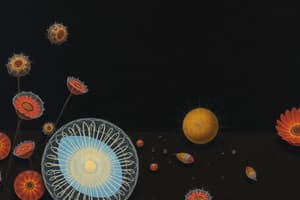Podcast
Questions and Answers
Which of the following organelles is NOT present in all cell types?
Which of the following organelles is NOT present in all cell types?
- Ribosome
- Chloroplasts (correct)
- Cytoplasm
- Cell membrane
The cell wall is present in both animal and plant cells.
The cell wall is present in both animal and plant cells.
False (B)
What is the main function of mitochondria in a cell?
What is the main function of mitochondria in a cell?
site of aerobic respiration
The fluid-filled sac containing water, sugars and salts is called a ______.
The fluid-filled sac containing water, sugars and salts is called a ______.
Match each organelle with its primary function:
Match each organelle with its primary function:
What is the basic unit of life?
What is the basic unit of life?
Unicellular organisms are made up of many cells.
Unicellular organisms are made up of many cells.
What process takes place in the mitochondria?
What process takes place in the mitochondria?
The inner membrane of the mitochondria is folded to give a large ___________.
The inner membrane of the mitochondria is folded to give a large ___________.
What are ribosomes responsible for?
What are ribosomes responsible for?
Plasmids are large structures of genetic material found in animal cells.
Plasmids are large structures of genetic material found in animal cells.
What type of genetic material are plasmids made of?
What type of genetic material are plasmids made of?
Match the cell structure with it's function:
Match the cell structure with it's function:
Which of the following organelles is found in both plant and animal cells?
Which of the following organelles is found in both plant and animal cells?
Bacterial cells have a nucleus.
Bacterial cells have a nucleus.
What is the primary function of mitochondria?
What is the primary function of mitochondria?
The cell wall of a plant cell is made of __________.
The cell wall of a plant cell is made of __________.
Match the following cell structures with their functions:
Match the following cell structures with their functions:
Which of the following statements is true regarding fungal cells?
Which of the following statements is true regarding fungal cells?
Plasmids are found in plant cells.
Plasmids are found in plant cells.
What role do plasmids play in genetic engineering?
What role do plasmids play in genetic engineering?
Flashcards
Cell Wall
Cell Wall
A rigid outer layer that provides structural support and protection to plant, fungal, and bacterial cells.
Mitochondria
Mitochondria
The site where aerobic respiration takes place, producing energy for the cell.
Chloroplast
Chloroplast
The site of photosynthesis in plant cells, where sunlight is converted into energy.
Cell Membrane
Cell Membrane
Signup and view all the flashcards
Cytoplasm
Cytoplasm
Signup and view all the flashcards
What is a cell?
What is a cell?
Signup and view all the flashcards
Unicellular organism
Unicellular organism
Signup and view all the flashcards
Multicellular organism
Multicellular organism
Signup and view all the flashcards
Cell ultrastructure
Cell ultrastructure
Signup and view all the flashcards
Ribosomes
Ribosomes
Signup and view all the flashcards
Plasmids
Plasmids
Signup and view all the flashcards
Aerobic respiration
Aerobic respiration
Signup and view all the flashcards
Vacuole
Vacuole
Signup and view all the flashcards
Study Notes
Cell Biology Overview
- Cell biology is the study of cells
- Cells are the basic unit of life
- Cells make up tissues and organs
Types of Organisms
- Unicellular organisms: Consist of a single cell, like bacteria
- Multicellular organisms: Consists of many cells, like humans (estimated 50 trillion cells)
Simple Cell Structure
- Cells have a cell membrane
- The inside of a cell is called cytoplasm
- Cells contain a nucleus
Cell Structures Found ONLY in Plant Cells
- Chloroplasts: Involved in photosynthesis
- Vacuole: Stores water and nutrients
- Cell wall: Provides support and protection
Cell Ultrastructure
- Mitochondria: Site of aerobic respiration (energy production)
- Lysosomes: Involved in breaking down waste materials
- Golgi apparatus: Processes and packages proteins
- Ribosomes: Site of protein synthesis
- Nucleus: Contains genetic material (DNA)
- Nucleolus: Found within the nucleus, site where ribosomes are assembled
- Endoplasmic reticulum: involved in protein and lipid synthesis
Cell Structure– Ribosomes
- Ribosomes are structures in the cytoplasm on which proteins are assembled from amino acids
Cell Structure– Plasmids
- Plasmids are tiny rings of genetic material (DNA) found in bacteria
- They can be used in genetic engineering to transfer genes
Cell Size
- Most plant and animal cells are between 0.025 µm and 60 µm.
- The largest human cell is the female egg cell (ovum), around 1,000 µm in diameter.
- The smallest human cell is the sperm cell, with a head around 5 µm long.
Plant and Animal Cell Differences
- Plant cells have a cell wall
- Plant cells have chloroplasts
- Plant cells have vacuoles
Plant and Fungal Cell Differences
- Plant cell walls are made of cellulose
- Fungal cells do not have chloroplasts
Fungal and Bacterial Cell Differences
- Fungal cells have mitochondria, a nucleus and a vacuole
- Bacterial cells do not have a nucleus and contain plasmids (extra DNA)
Organelle Location
- Identify organelles found in plant and animal cells
Studying That Suits You
Use AI to generate personalized quizzes and flashcards to suit your learning preferences.



